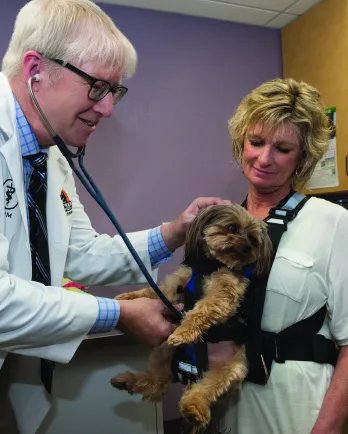Q&A with Dr. Marty Becker, “America’s Veterinarian” and Grey Muzzle Advisory Board Member
We're pleased to share this interview between our Advisory Board member, Dr. Marty Becker and our Board Member, Denise Fleck regarding Fear Free.
Fear Free is when veterinary health care professionals “Take the pet out of petrified” and “Put the treat into treatment!” and where pet owners are “Helping pets live happy, healthy, full lives” via online and in-person education. Courses provide learners and pet lovers with the knowledge and tools to not only look after a pet’s physical well-being, but his or her emotional well-being as well. We know we must feed the pet’s mind as well as the body so we make sure that in-home enrichment and Fear Free training are front-and-center with pet professionals and pet owners alike.
Founded by “America’s Veterinarian,” Dr. Marty Becker, Fear Free has become one of the single most transformative initiatives in the history of companion animal practice, with over 21,000 veterinary and pet professionals committed to becoming Fear Free certified.
Grey Muzzle Board Member, Denise Fleck, recently had the chance to talk, as well as laugh, with Dr. Becker, and here’s how the conversation about their favorite topic - pets - went…
GMO: I'm sure it was a long-time coming, feeling for fearful pets observed in practice, but was there a singular incident that caused you to develop your Fear Free Initiative?
DR. BECKER: Yes, but it wasn’t in practice, it was in a lecture room. I gave a keynote back in 2009 on Vancouver Island in Victoria. The next day a board certified behaviorist, Dr. Karen Overall, spoke. I was in the back of the room listening as she started, “Fear is the worst thing a social species can experience. It causes permanent damage to the brain!” She went on to explain signs of fear and panic in animals, and I realized that although I had the best of intentions, wanting to help, never hurt my animal patients…I had actually been causing some physiological damage. I was absolutely nauseous! Think about it. An animal comes into a practice and on the corner of the wall outside the door smells that vertical surface where 1,000 other dogs left signals of fear behind. They got to the scale and/or get lifted up on to a cold, slippery table where again, the fear pheromones exude. The vet, towering above, makes direct eye contact with the full width of his or her body towering over the pet and then comes the cold stethoscope that smells of fear before the animal gets 2 or 3 ‘bee stings’ in the form of vaccinations and then gets the heck out of there! If any parts of the clinic (probably most) have been cleaned with bleach, the poor pet, so dependent on his sense of smell, is now nose-blind for 7 days due to the chemical! I, and others, were just not seeing this collateral damage to getting dogs and cats examined. Dr. Overall got me to this transformative moment when she drew a parallel to the human health care system of the 50s-60s, and I was reminded of being told to “Not embarrass the doctor,” by crying when I was given a shot in my youth. Children are dependent beings. They don’t go to doctor by free-will and depending on age, you can’t explain to them that, ‘You’re going to get an injection that may sting, but it’s going to fight bacteria in your body and relief of your aches and pains may be only moments away.” Nobody gets into veterinary medicine to make life worse for animals, and I thought about how my granddaughter LOVES to go to the dentist. She’s placed in a room with 6 chairs (not all alone) and gets to pick the colors of the LED lights, choose a video on screen, is given noise-cancellation headphones, a blanket, even animal-assisted therapy if needed, while her mom supplies the neck massage. When she leaves, it isn’t a toothbrush and paste she departs with, but a ‘Toys R Us’-like menagerie! Pediatric medicine, dentistry and oncology are now doing it right. They look after the physical and emotional well-being of the patient, and we must do the same for animals. Leaving there, especially since I feel I’m in an industry leadership position, all I could ask myself is, “What have we done?” I went back to Board of Veterinary Behavior, and asked, “How can we fix it?” We gathered advisory group which has now grown to 225 people and because of Dr. Overall, I was moved to action. She was powerful! I graduated from veterinary school back in 1980 and had been taught that pets didn’t feel pain like we do. Baloney! They have the same neuropathways and feel the emotions of fear, anxiety and stress and all that lives in the amygdala (almond-shaped part of the brain that stores emotions). If nails trimmed too short, the pet feels pain and continues to be disturbed by the sight of the clippers. Same with an injection and the syringe. We now understand the benefits of giving pain and anxiety meds before the first person lays hands on a pet.
GMO: Can you describe some of the fearful behavior you have seen in cats and dogs over the years – is it the typical fight or flight?
DR. BECKER: This is really interesting - another epiphany during Dr. Overall’s speech! Let’s take a dog… licking lips, yawning, salivating, shivering, making circles, leaning away from stress, avoidance, hiding, panting, heart racing, shaking as if they were wet. Some even lay with eyes closed which is farthest down on the Defense Cascade, meaning here’s where they have given up the battle. In the Defense Cascade, first comes ‘Alert’ (muscles tense, heart rate increases) followed by the desire for ‘Fight or Flight’ (active defense to deal with the stress), and lastly ‘Collapsing Immobility” (pet shuts down in response to an inescapable threat). The dog or cat is experiencing the greatest degree of trauma.
GMO: I see "Fear Free" a bit like having a good "bedside manner" but on steroids! Do you hope or do you think it may someday be possible that Fear Free is part of veterinary school training?
DR. BECKER: Veterinarians need to see themselves as Pediatricians for life. We can’t explain that what we’re doing is to relieve pain, so we have to show this through gentleness and species-appropriate actions. Pets aren’t getting the care they need as some owners feel it is more stressful to bring them to the vet. Many dogs and cats are afraid and their leukocytes shift (white blood cells of the immune systems), blood panels and other testing doesn’t then provide true readings of their health due to elevated fear and anxiety. The veterinary profession is the only one where the injury rate (cat scratch or a dog bite) is 100% for every person every year. We’re obviously coming at the animals’ fear all wrong.
GMO: What do you feel is the "essence" of Fear Free? Is there a key component that makes this work for most pets?
DR. BECKER: Use your ‘sanctuary voice’ not your ‘game day voice’ for starters. Have the room loaded -- everything in the room ahead of time so you don’t keep going in and out. Reduce your profile by turning sideways to the pet and give soft glances, not direct contact. Give the animal the choice as to where exam will take place, don’t automatically get them up on that table. Use control or positioned compliance as oppose to restraint, offer high value treats to lure them to you. Tent the skin. Release. Tent the skin. Release. Tent the skin, and then give the injection. Don’t just grab and bee sting them! Your voice, body language, physical touch, cleaning of instrumentation all contribute. We clean stethoscopes and all tools with a peroxide based cleaner and then wipe them with species-appropriate pheromones, not the fear ones! Fear Free is a way of thinking about catering to the pet, not just getting him in and out and trying to prevent being injured yourself.
GMO: Do you approach Fear Free differently with cats than you do dogs? Explain.
DR. BECKER: Beginning with curating the room differently, cats get warmed towels sprayed with Feliway®, ‘I Calm Cats’ music is played (it’s recorded at their resting heart rate) and species-specific pheromones are wiped on the table and all instrumentation (stethoscopes, otoscopes, the scale, etc). What do dogs usually do before they enter vet office? Answer nature’s call right outside it. Cats don’t get this opportunity, so they are stressed out with a full bladder besides. We place the kitty carrier on the floor and have catnip, a litter box, and water nearby. We ask clients to bring the pets in hungry, and for our feline friends we offer anchovy paste, shrimp, herring, chicken liver and whip cream, both cats and dogs love whip cream! For dogs, we offer Peanut Butter Cap’n Crunch®, freeze dried meat, bacon cheese spray, but of course tell clients that these treats are for their visit here, not a regular part of the diet! At my practice, 80% of dogs & cats now accept treats from the vet or tech where before, only 20% would. It’s making a difference.
GMO: Tel us about the Fear Free programs.
DR. BECKER: The goal of Fear Free is to increase happy & calm and reduce anxiety & stress. 25,000 individuals have paid & registered for certification and we expect that number to climb to 50,000 by the end of 2018. Every April, a new level is available to ramp up your learning. On the Fear Free Happy Homes website, we share ways pet parents can reduce anxiety and stress while also account for enrichment. Cats and dogs are natural born athletes and hunters, cats stalk and actually need (not just want) places to hide for their emotional well-being. Tips are available as well as listings of veterinarian, groomers and trainers that are Fear Free Certified. We want the new generation of pet owners to care for their emotional well-being by providing opportunities for them to live well-balanced lives.
GMO: Any Fear Free success stories to share?
DR. BECKER: Joy, a 14-year old Black Lab was totally doted upon by her owner. The home was an homage to Joy with her name spelled out on the door mat, wind chime, everywhere, but a trip to the vet would cause Joy excessive fear. He mom felt she’d have to let Joy (who was experiencing medical issues) die early rather than stress her at the attempt to get medical care – she feared she would hurt by helping. Joy’s panic was so excessive that her blood work and exam results would be skewed if she came in that state, so I asked her mom to have Joy come in hungry, and…come to my office prior to the visit for “chill pills,” a green tea extract. Once in the exam room, I offered Joy deli turkey and avoided eye contact. The “I Calm Dogs” music, composed at a dog’s resting heartbeat, played in the background, and like never before…Joy started wagging while her owner sobbed happy tears. My daughter was at the practice and gave Joy a massage and made her “sit” for a treat. The otoscope I used to look in Joy’s ears was cleaned with the peroxide solution, not bleach, and was wiped down to the handle with friendly doggie pheromones! Joy now LOVES to come for office visits and receives the medical attention she needs.
Rockey too was an older animal, a cat who could make everyone at the practice want to call in sick if they knew he was scheduled to come in. He was a skilled fighter who could tear you apart! You could literally play “connect the dots” with the injuries he could inflict on the team. On his cage was a sign: “Caution: Fractious Cat,” and that was another revelation I’ll share in a moment. Prior to his visit, I got his owner to give him the magic carpet ride to the practice on a blanket sprayed with Feliway®, put a Thundershirt® on him, and then we used the parking lot, basically each cat’s vehicle, as the waiting room. When Rockey came in, I wrote his name in EZ Cheese on a mat, and he started eating away. Before long he rubbed against me with his cheek and purred while all the humans gasped in disbelief! Now back to his carrier, we changed that sign to: “Caution: Fearful Cat” which is more than words, it’s a thought process. Before, we warning everyone that they needed to be prepared for battle. Now we understand in actuality, what we need to do for pets like Rockey is protect them. Realize their fear and cater to their comfort rather than in turn fearing them.
GMO: Dr. Becker, where can we learn more?
DR. BECKER: www.FearFreePets.com and www.FearFreeHappyHomes.com
GMO: Do you have other projects happening or is there anything else you would like us to know?
DR. BECKER: Just that it’s a no brainer. Pets love us unconditionally. They make us smile and laugh, and we had no idea we were harming them emotionally. No pet professional gets into this wanting to make life worse for an animal. Groups in 34 countries have already become Fear Free Certified, and plans are underway to begin issuing certifications to practices (like the American Animal Hospital Association – AAHA – does looking for a different set of standards). The course materials will be translated into Spanish, Portuguese, Korean & Mandarin, and we’re developing courses for avians, exotics and equines as well as specialty modules and content tailored to groomers and trainers. Certification is always free for Veterinary students and those working in Shelter Medicine. Owners and veterinarians care for our pets from ‘Birth to Earth,’ and along every step of the way, we must account for the emotional as well as their physical well-being.
About the Contributor: For close to 20 years, Dr. Becker has been the popular veterinary contributor on ABC’s Good Morning America. He is a founding member of The Dr. Oz Show’s Core Team Oz and a member of the Dr. Oz Medical Advisory Panel. In April 2012, the World Small Animal Veterinary Association named him the recipient of their annual WSAVA Hill’s Excellence in Veterinary Healthcare Award (also known as the Global Companion Animal Veterinarian of the Year). He is the Chief Veterinary Correspondent for the American Humane Association and a member of the AHA Board of Directors. He has written 23 books that have sold more than 7 million copies, including three New York Times best sellers. He has been a contributor to Parade magazine, Reader’s Digest and AARP.com. Dr. Becker is an adjunct professor at his alma mater, the Washington State University College of Veterinary Medicine as well as College of Veterinary Medicine at Colorado State University and the Research Center for Human-Animal Interaction at the University of Missouri’s College of Veterinary Medicine. He has lectured at every veterinary school in the United States and been named Companion Animal Veterinarian of the year by Delta Society (Now Pet Partners) and the American Veterinary Medical Association. He practices, when his schedule allows, at two veterinary hospitals in north Idaho because he loves veterinary medicine, pets and the people who care for them. His special fondness for older pets has led him to a spot on the Advisory Board of The Grey Muzzle Organization.



